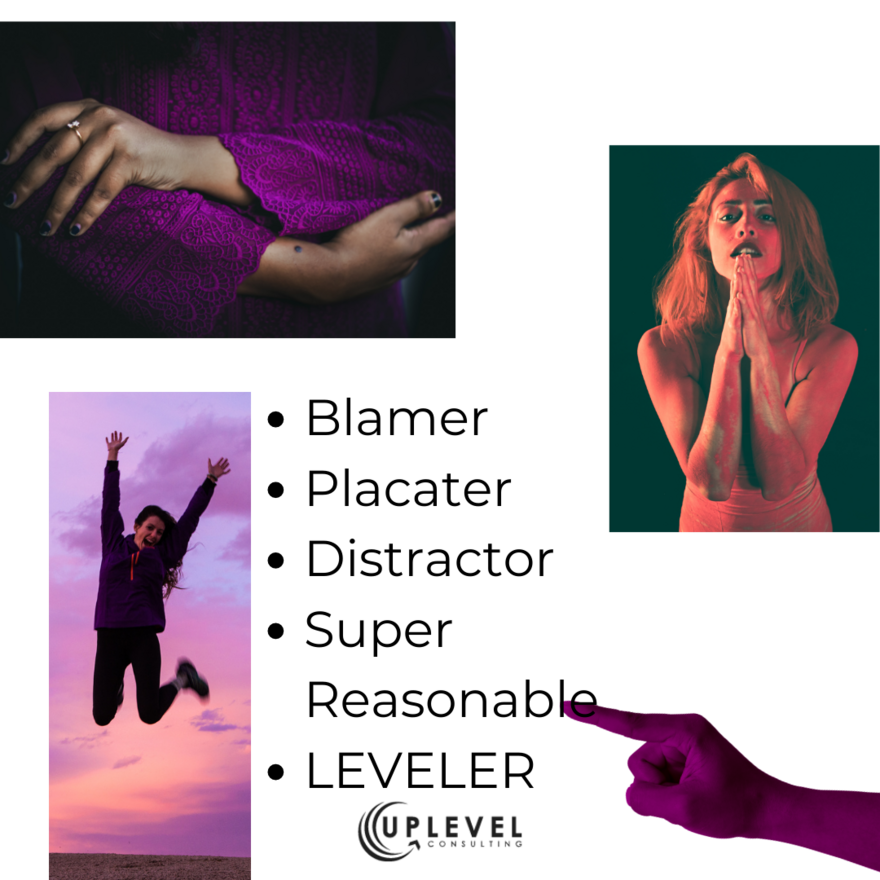Feel Attacked? Learn Your Stress Communication Style

We are living in a time where we are surrounded with confrontations and conflict. As you know, it can be quite stressful!
When you get stressed out, emotions run high, and you may find yourself reacting in a way that doesn’t portray you as the best version of yourself (or your personal brand).
A prominent psychotherapist, Virginia Satir, pointed out that we react to both stress and threats to our self-esteem (ie. think intelligence insults) by taking on one of five defensive communication styles.
Understanding these five styles can help us to be more proactive instead of reactive. Doing so can help strengthen our brand and level of influence. Which style do you see yourself being? Can you think of someone you know who fits one of these styles?
The Blamer:
When someone is being the Blamer, they are angry with the world. The Blamer may act controlling, relentlessly nitpicky, grumpy and speak in generalizations like, “you never do anything right.” When one is being the Blamer they are on the offensive. Anger is what they use to mask their deep-seated fear which they are unable to own or express.
The Placater:
When someone is taking on this role they are acting like a “people pleaser” or “martyr.” They are likely apologetic, timid, even a pushover. They don’t like to say “no” to anyone. They don’t like rocking the boat, so they aim for peace at any price. They have difficulty expressing anger and hold their feelings inside which can result in them feeling depressed.
The Super-Reasonable:
This style is cool, calm and collected. They appear logical, disconnected from feelings, and tend to quote facts, statistics, authorities and tradition. They may use elaborate language and expect people to perform efficiently and conform to the rules. They hate admitting their mistakes and are uncomfortable around displays of emotion. They’re often described as rigid, resistant and dogmatic.
The Distractor:
This style is often seen as unfocused, talkative, and active to the point of being frantic. Sometimes they may even be considered out of touch with reality. They may avoid eye contact and change the subject or ignore a topic completely. Someone in this role may procrastinate and be unproductive, moving from one thing to the next. The Distractor is frightened, distrustful and worried. The underlying principle is, “if I ignore the problem, it doesn’t exist.”
The Leveler is considered the productive, harmonious style. Levelers express themselves without blaming, placating, distracting or being super-reasonable. They respond with integrity, feelings and behavior that are heart-led and straightforward. They can manage problems realistically with their ability to accurately assess situations and communicate their feelings desires and intentions honestly. In short, they level with people. They are authentic and have confidence speaking in any conversation, even difficult ones.
Leveling can be difficult when talking about emotional, hot-button topics but being the Leveler will help you to…
- Convey information or solve problems
- Substitute anger for assertiveness
- Stand up for your needs (non-aggressively)
- Replace fear with concern for others
- Take on a fresh perspective, and
- Stay calm and rational while being willing to be vulnerable
Being a Leveler is what I call being a person of influence. This person has 360-degrees of communication confidence. It doesn’t mean all situations are easy for the Leveler, rather it means you are confident to take on difficult, confrontational conversations in professional way when necessary. That’s conversational power! And it’s part of what we create in the 90-day UpLevel Your Influence program.
If you’re curious about how this program might help you, your brand and your business sign up for a free 1-hour Influence Audit where you’ll get an evaluation, tips to boost your level of influence and can ask any questions about the program.

0 comments
Leave a comment
Please log in or register to post a comment